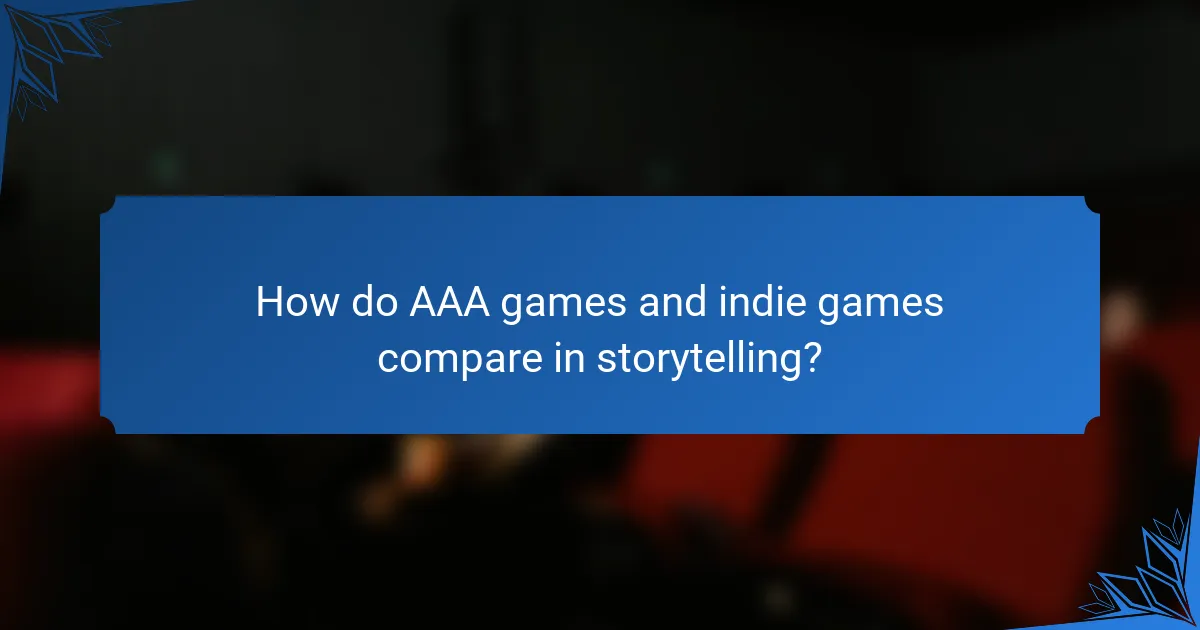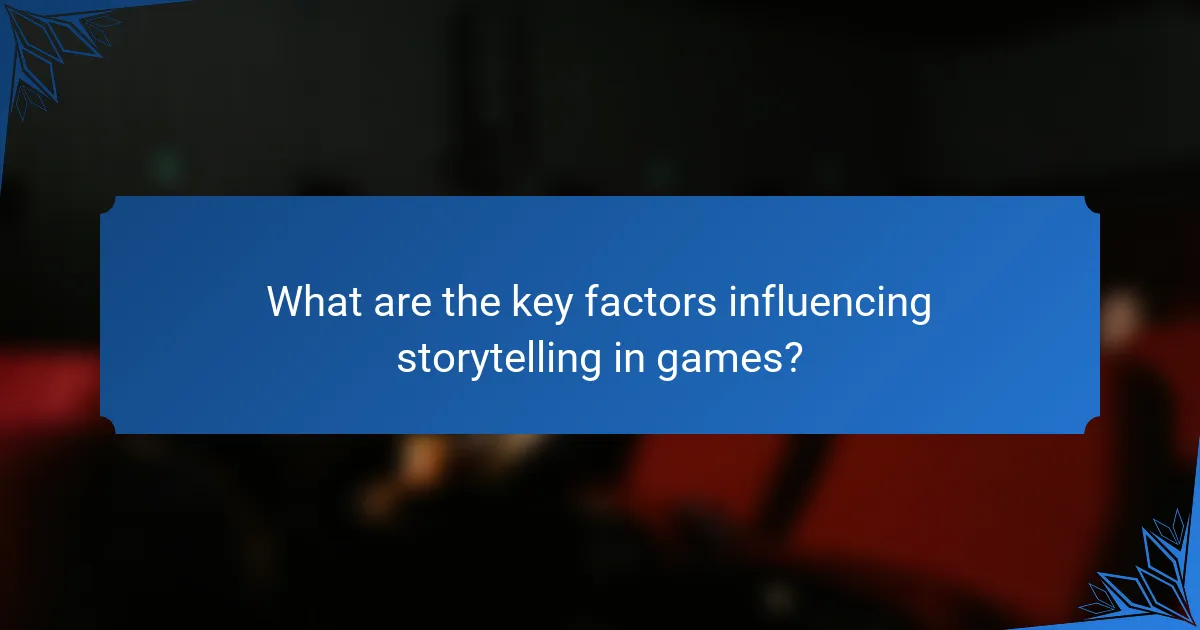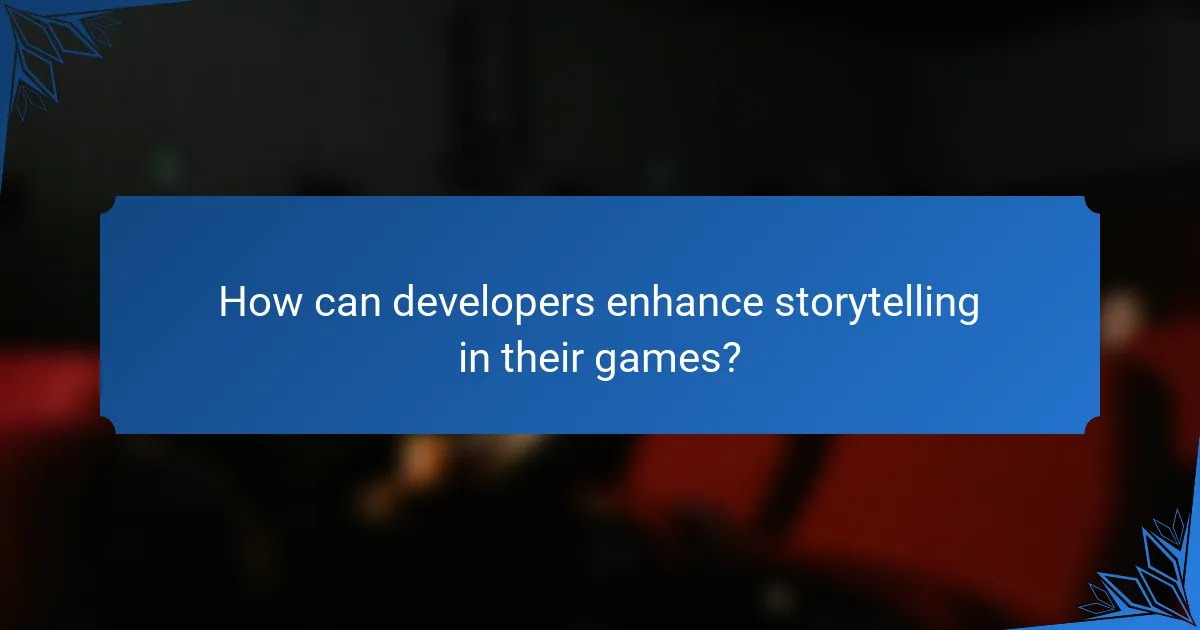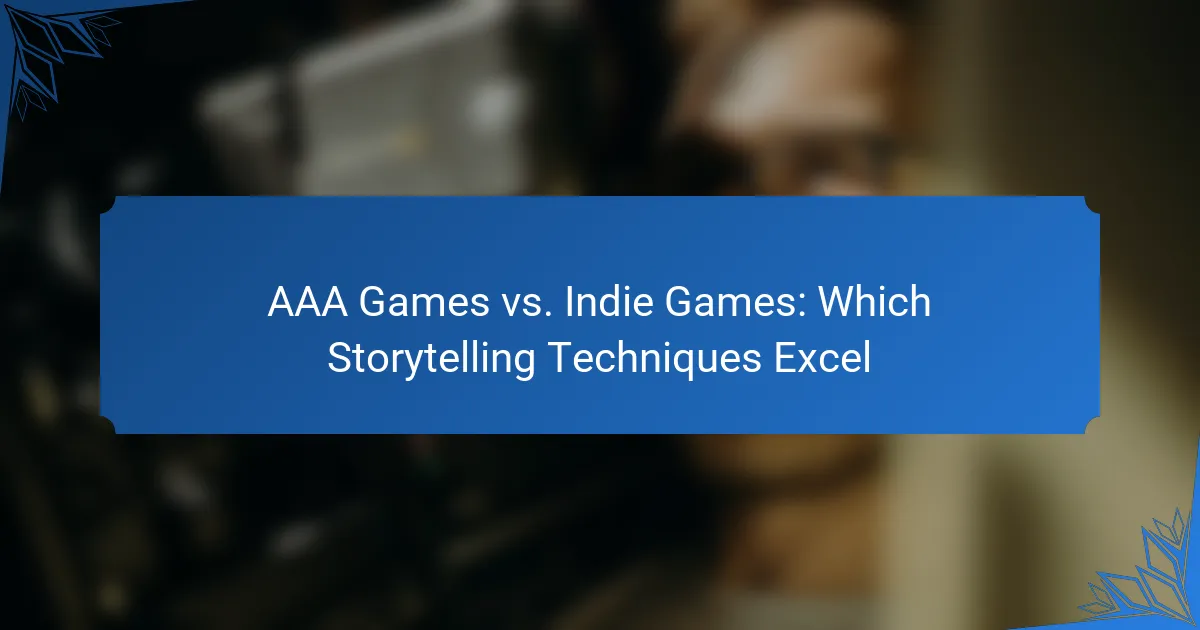The debate between AAA games and indie games reveals distinct storytelling techniques that cater to different player experiences. AAA games leverage high production values and intricate narratives to create immersive worlds, while indie games often focus on creativity and emotional depth, offering unique storytelling approaches that resonate on a personal level. Both styles contribute to the evolving landscape of video game narratives, each excelling in its own right.

What storytelling techniques excel in AAA games?
AAA games often utilize advanced storytelling techniques that enhance player engagement and immersion. These techniques include high production values, character-driven narratives, and intricate world-building that collectively create a compelling gaming experience.
High production value narratives
High production value narratives in AAA games are characterized by top-notch graphics, voice acting, and sound design. These elements work together to create a cinematic experience that draws players into the story. For example, games like “The Last of Us Part II” showcase stunning visuals and emotional performances that elevate the narrative.
Investing in high production values can significantly impact player perception and enjoyment. However, this often requires substantial budgets, sometimes reaching hundreds of millions of dollars, which can limit the number of studios capable of producing such titles.
Character-driven plots
Character-driven plots focus on deep, relatable characters whose development is central to the story. AAA games often invest in character arcs that evolve throughout the gameplay, allowing players to form emotional connections. Titles like “God of War” exemplify this with Kratos’ transformation and relationship with his son.
Creating strong character-driven narratives requires careful writing and character design. Developers should ensure that characters have distinct motivations and flaws, which can resonate with players and enhance the overall experience.
Complex world-building
Complex world-building in AAA games involves creating rich, immersive environments that feel alive and interconnected. This includes detailed lore, diverse cultures, and intricate histories that players can explore. Games like “The Witcher 3: Wild Hunt” are renowned for their expansive worlds filled with quests and stories that enrich the main narrative.
Effective world-building requires a balance between depth and accessibility. Developers should provide enough detail to engage players without overwhelming them. Utilizing in-game codexes or lore books can help players discover the world at their own pace, enhancing their overall experience.

What storytelling techniques excel in indie games?
Indie games often excel in storytelling through unique approaches that prioritize creativity and player engagement. These techniques include innovative narrative structures, personalized storytelling experiences, and a strong emphasis on emotional depth.
Innovative narrative structures
Indie games frequently utilize unconventional narrative structures that challenge traditional storytelling methods. For example, games like “Her Story” employ non-linear storytelling, allowing players to piece together the plot through fragmented video clips. This approach encourages exploration and active engagement, making the narrative feel more personal.
Another technique is the use of branching storylines, where player choices significantly impact the outcome. Titles such as “Life is Strange” showcase how decisions can lead to multiple endings, enhancing replayability and player investment in the story.
Personalized storytelling experiences
Indie games often create personalized storytelling experiences by allowing players to influence character development and plot progression. Games like “Firewatch” focus on character relationships, where dialogue choices shape interactions and emotional connections. This level of personalization makes the narrative feel more relevant to each player.
Additionally, some indie titles incorporate player backstories or preferences into the gameplay, further enhancing immersion. For instance, “Undertale” adapts its narrative based on the player’s actions, leading to a unique experience tailored to individual choices.
Emphasis on emotional depth
Many indie games prioritize emotional depth, often exploring complex themes and human experiences. Titles such as “Celeste” tackle issues like mental health and personal struggle, resonating with players on a deeper level. This focus on emotional storytelling can create a lasting impact, encouraging players to reflect on their own lives.
Moreover, indie developers often use minimalist art styles and soundtracks to evoke strong emotions. The combination of simple visuals and poignant music can enhance the storytelling experience, making moments feel more profound and memorable.

How do AAA games and indie games compare in storytelling?
AAA games typically feature high-budget production values and extensive resources, allowing for complex storytelling techniques. In contrast, indie games often rely on innovative narratives and unique perspectives due to their smaller budgets and teams.
Budget and resource differences
AAA games often have budgets in the millions, enabling them to hire large teams of writers, voice actors, and artists. This financial backing allows for extensive world-building, high-quality graphics, and elaborate cutscenes that enhance storytelling.
Indie games, on the other hand, usually operate with budgets that can range from a few thousand to a couple of million dollars. This limitation often leads to creative storytelling methods, such as minimalist art styles or text-based narratives, which can resonate deeply with players.
Audience engagement strategies
AAA games frequently use marketing campaigns and franchise branding to engage audiences, creating anticipation through trailers and teasers. They often aim for broad appeal, which can sometimes dilute unique storytelling elements in favor of mass-market trends.
Indie games tend to foster community engagement through social media and grassroots marketing. Developers often interact directly with players, using feedback to shape narratives and gameplay, which can lead to more personalized and impactful stories.
Creative freedom versus market expectations
AAA developers face significant market expectations, which can constrain creative storytelling. They often prioritize proven formulas to ensure financial success, potentially sacrificing originality in favor of familiar tropes.
Indie developers enjoy greater creative freedom, allowing them to explore unconventional narratives and themes. This flexibility can lead to innovative storytelling approaches that challenge norms and offer fresh experiences, appealing to niche audiences.

What are the key factors influencing storytelling in games?
Storytelling in games is influenced by various factors, including player agency, game mechanics, and art style. These elements shape how narratives are delivered and experienced, impacting player engagement and emotional connection.
Player agency
Player agency refers to the degree of control players have over their choices and actions within a game. In AAA games, this often manifests through branching narratives and multiple endings, allowing players to influence the story significantly. Indie games may focus on more personal or unique experiences, often offering a narrower scope of choices but deeper emotional resonance.
When designing for player agency, consider how choices affect the narrative flow. Ensure that decisions feel meaningful, as players are more likely to engage with stories that reflect their actions. Avoid overwhelming players with too many options, which can dilute the impact of their choices.
Game mechanics integration
Game mechanics integration involves how gameplay elements support and enhance the storytelling experience. In AAA titles, complex mechanics often align with high production values, creating immersive worlds where gameplay and narrative are intertwined. Indie games may utilize simpler mechanics but can still create powerful storytelling through innovative design choices.
To effectively integrate mechanics with storytelling, ensure that gameplay reinforces narrative themes. For example, a game about survival might incorporate resource management as a core mechanic, reflecting the character’s struggles. Balance is key; mechanics should enhance rather than distract from the story.
Art style and presentation
Art style and presentation play a crucial role in conveying a game’s narrative tone and atmosphere. AAA games typically feature high-fidelity graphics and cinematic presentation, which can enhance emotional engagement. In contrast, indie games often utilize unique or stylized art to create distinct identities, sometimes prioritizing creativity over realism.
When choosing an art style, consider how it complements the story being told. A whimsical art style may suit a lighthearted narrative, while a darker, more realistic approach could enhance a serious theme. Consistency in presentation is vital; mismatched art and narrative can confuse players and weaken the overall experience.

What are the emerging trends in game storytelling?
Emerging trends in game storytelling focus on enhancing player engagement through innovative techniques. These trends include advancements in interactive storytelling, the integration of AI in narrative design, and cross-media storytelling approaches that expand the narrative universe.
Interactive storytelling advancements
Interactive storytelling advancements allow players to influence the narrative through their choices, creating a personalized experience. Techniques such as branching dialogue trees and dynamic world events enable players to see the consequences of their actions, fostering deeper emotional connections to the story.
Games like “The Witcher 3” and “Detroit: Become Human” exemplify these advancements, offering multiple endings based on player decisions. Developers should consider balancing player agency with coherent storytelling to avoid confusion and maintain narrative flow.
Use of AI in narrative design
The use of AI in narrative design is revolutionizing how stories are crafted in games. AI can analyze player behavior and adapt the storyline in real-time, creating a unique experience for each player. This technology allows for more complex character interactions and responsive environments.
For instance, AI-driven systems can generate dialogue or plot points based on player choices, making the narrative feel more alive. However, developers must ensure that AI-generated content aligns with the overall story to preserve coherence and quality.
Cross-media storytelling approaches
Cross-media storytelling approaches involve integrating narratives across various platforms, such as games, films, and books. This technique allows for a richer storytelling experience, as players can explore different facets of the story in multiple formats. For example, a game might have a companion series that expands on character backstories or plotlines.
Successful cross-media examples include the “Halo” franchise and “The Witcher” series, where stories are told through games, novels, and television. Developers should consider how each medium can enhance the overall narrative while ensuring consistency in character development and plot progression.

How can developers enhance storytelling in their games?
Developers can enhance storytelling in games by actively integrating player feedback and collaborating with narrative designers. These strategies allow for a more immersive and engaging experience, ensuring that the story resonates with players and adapts to their preferences.
Incorporating player feedback
Incorporating player feedback is essential for refining storytelling in games. Developers can gather insights through surveys, beta testing, and community forums to understand player preferences and pain points. This feedback loop can lead to adjustments in character development, plot pacing, and dialogue choices.
For example, if players express confusion about a plot twist, developers can clarify the narrative or adjust the storytelling mechanics. Regularly updating the game based on player input can significantly enhance engagement and satisfaction.
Collaborating with narrative designers
Collaborating with narrative designers is crucial for creating a cohesive and compelling story. Narrative designers specialize in crafting narratives that align with gameplay mechanics, ensuring that the story feels integrated rather than tacked on. This collaboration can lead to richer character arcs and more meaningful player choices.
Developers should involve narrative designers early in the development process to establish a strong foundation for the story. Regular brainstorming sessions and workshops can help align the creative vision and identify potential storytelling pitfalls before they become problematic.



